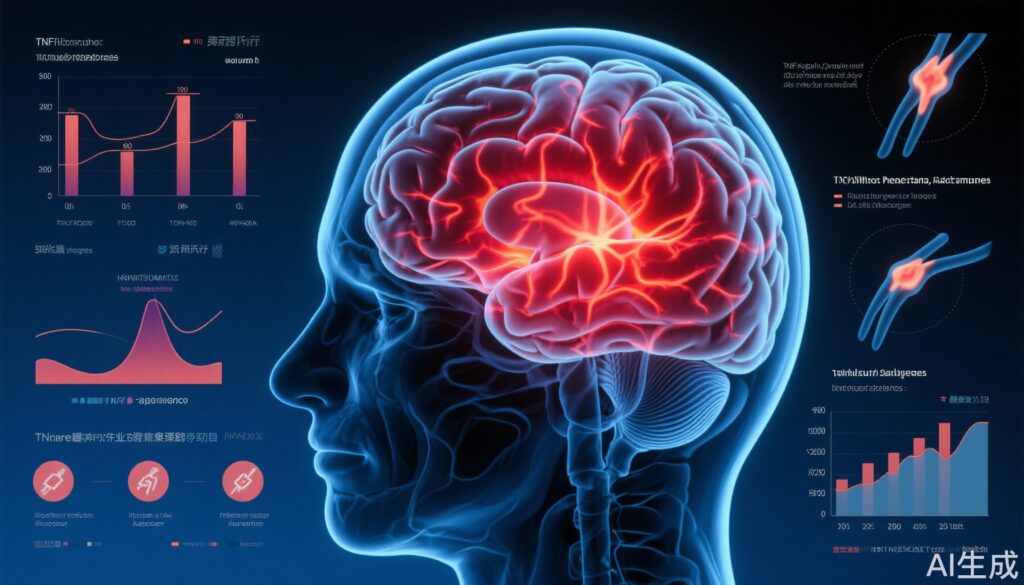Highlights
- The PreCePra phase 3 trial demonstrates that high CNS pain activation on fMRI predicts a better clinical response to TNF inhibition in rheumatoid arthritis (RA).
- Patients with high disease-associated brain activation had a significantly higher rate of achieving low disease activity after 12 weeks of certolizumab pegol treatment.
- This study provides a potential objective biomarker for guiding biologic therapy in RA, addressing the challenge of subjective response metrics.
Clinical Background and Disease Burden
Rheumatoid arthritis (RA) is a chronic, systemic autoimmune disorder that primarily affects synovial joints, causing pain, swelling, and ultimately joint destruction if inadequately controlled. TNF inhibitors are a mainstay of treatment for patients with moderate to severe RA who do not respond sufficiently to conventional synthetic disease-modifying antirheumatic drugs (csDMARDs). However, approximately 40–50% of patients fail to achieve a meaningful response to TNF inhibitors, and reliable predictors of treatment success remain elusive. The subjective nature of current composite response criteria, which incorporate patient-reported outcomes such as pain and global disease activity, further complicates the identification of objective response predictors.
Research Methodology
The PreCePra study was a phase 3, multicentre, double-blind, placebo-controlled, parallel-group randomized clinical trial conducted across six rheumatology centers in Germany, Portugal, and Serbia. Adults (aged ≥18 years) with active RA, defined as persistent disease activity despite at least one csDMARD, were eligible. At baseline, all participants underwent functional MRI (fMRI) brain scans to assess CNS pain activation, a proxy for central sensitization or the brain’s representation of RA-related disease.
Based on fMRI results, patients were stratified into high or low CNS activation groups and randomly assigned in a 2:1 ratio to receive either certolizumab pegol (400 mg subcutaneously at weeks 0, 2, and 4, then 200 mg every other week for up to 24 weeks) or placebo. Both patients and clinicians were blinded to group allocation. The primary endpoint was the proportion of patients achieving low disease activity (Disease Activity Score in 28 joints [DAS28] ≤3.2) at week 12, analyzed using the intention-to-treat principle.
Key Findings
Out of 148 screened patients, 139 were randomized: 49 to the high-volume certolizumab pegol group, 43 to the low-volume certolizumab pegol group, and 47 to placebo. The study population was predominantly female (71%). At week 12, the proportion of patients achieving low disease activity (DAS28 ≤3.2) was:
- High-volume certolizumab pegol: 28/49 (57%)
- Low-volume certolizumab pegol: 19/43 (44%)
- Placebo: 12/47 (26%)
The response rate in the high-volume certolizumab pegol group was significantly greater than placebo (p=0.0017), whereas the difference between low-volume and placebo was not statistically significant (p=0.063). The number needed to treat (NNT) for high-volume patients was approximately 3.7 compared to placebo, indicating a clinically meaningful effect size.
Adverse events related to treatment were reported in 22 certolizumab pegol recipients and three placebo recipients, with no unexpected safety signals.
Mechanistic Insights or Biological Plausibility
The study leverages the hypothesis that CNS pain processing, as measured by fMRI, may reflect underlying disease activity and/or pain sensitization in RA. Patients with high brain activation in pain-related regions may have a more pronounced neuroimmune component to their disease, rendering them more responsive to TNF blockade. This objective marker may thus serve as a surrogate for identifying patients most likely to benefit from TNF inhibitors, mitigating the confounding effects of subjective symptom reporting.
Expert Commentary
Recent clinical guidelines, such as those from EULAR and ACR, emphasize the need for precision medicine approaches in RA to optimize biologic therapy allocation. The use of functional neuroimaging as a predictive tool represents a novel step toward this goal. However, experts caution that widespread implementation requires validation in larger, diverse cohorts and integration with other clinical and serological markers.
Controversies or Limitations
Several limitations merit discussion:
- The study’s relatively small sample size and geographical restriction may limit generalizability.
- The cost, availability, and standardization of fMRI as a predictive tool remain significant barriers to clinical translation.
- No patient or lived experience input was included in the study design.
- The mechanistic underpinnings of CNS activation and its modulation by TNF inhibition require further elucidation.
- There is a potential for spectrum bias, as only patients failing at least one csDMARD were included.
Conclusion
The PreCePra phase 3 study provides compelling evidence that high disease-associated CNS pain activation, as measured by fMRI, predicts clinical response to TNF inhibitor therapy in RA. This finding advances the search for objective biomarkers in rheumatology and offers hope for more individualized treatment strategies. Further research is needed to validate these results, clarify underlying mechanisms, and assess the feasibility of integrating neuroimaging into routine care.
References
1. Hess A, Tascilar K, Schenker HM, Konerth L, Schönau V, Sergeeva M, et al. Disease-associated brain activation predicts clinical response to TNF inhibition in rheumatoid arthritis (PreCePra): a randomised, multicentre, double-blind, placebo-controlled phase 3 study. Lancet Rheumatol. 2025 Aug;7(8):e565-e575. doi: 10.1016/S2665-9913(25)00032-3. PMID: 40570879.
2. Smolen JS, Landewé RBM, Bijlsma JWJ, et al. EULAR recommendations for the management of rheumatoid arthritis with synthetic and biological disease-modifying antirheumatic drugs: 2023 update. Ann Rheum Dis. 2023;82:3–18.
3. Singh JA, Saag KG, Bridges SL Jr, et al. 2015 American College of Rheumatology Guideline for the Treatment of Rheumatoid Arthritis. Arthritis Rheumatol. 2016;68(1):1-26.



